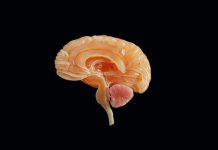
In a new study, researchers found that a lack of a protein in the brain that keeps the tissues healthy as we age is linked to Alzheimer’s disease.
They found that IL-33 was critical for the removal of “garbage” from brains, keeping cells healthier for a longer period of time, and helping minimize damage over time.
Early detection of the deficiency of Interleukin 33 (IL-33) with clinical interventions could help the brain age in a healthier way to prevent degenerative diseases.
The research was conducted by a team from The University of Texas Health Science Center at Houston (UTHealth).
In the brain, normal neurons repair themselves by discarding abnormal proteins, similar to taking out the garbage.
Although neurons get older in humans beginning around 35 to 40 years of age, continuing to minimize the ‘garbage’ or damaged DNA and proteins that buildup in the organs allow neurons to stay healthy and function properly – even as people age.
Without those anti-aging processes, human neurons begin to die or no longer function correctly at a much higher rate by 60 to 65 years of age.
In most people with Alzheimer’s, symptoms first appear in their mid-60s and the brain disorder slowly destroys memory and thinking skills and eventually the ability to carry out the simplest tasks.
According to the team, the IL-33 molecule serves as a control agent and accelerates the drainage of abnormal proteins from the brain.
The newly discovered mechanism is a “sewage” system in the brain called the glymphatic system, which is composed of tiny spaces surrounding the veins that get rid of brain debris.
Defects in the glymphatic system, a waste clearance pathway for the central nervous system, would lead to the accumulation of abnormal proteins that are linked to Alzheimer’s disease in humans.
The study unveils the importance of a molecule called aquaporin 4, a water “pump” in the brain that drives water to remove the waste surrounding the neuron close to blood vessel tubing in the brain.
However, once the IL-33 gene is knocked out, these small “pumps” are no longer produced.
The team says when these mechanisms are broken, the brain accelerates in aging, which leads to Alzheimer’s disease and death.
Since this process largely starts at middle age, they propose the period between adulthood and old age is a good time to review levels of IL-33 and other related biomarkers, such as those found in blood and urine, for early diagnosis of Alzheimer’s disease.
Once the brain is in a degenerative state, it is too late to reverse damages.
According to the Centers for Disease Control and Prevention, 5.7 million Americans are estimated to be living with Alzheimer’s disease in 2018.
It is the fifth leading cause of death for adults aged 65 years and older, and the sixth leading cause of death for all adults.
One author of the study is Yahuan Lou, Ph.D.
The study is published in Molecular Psychiatry.
Copyright © 2021 Knowridge Science Report. All rights reserved.



